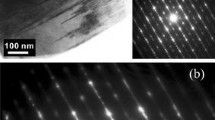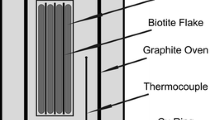Abstract
New equilibrium experiments have been performed in the 20–27 kbar range to determine the upper thermal stability limit of endmember deerite, Fe 2+12 Fe 3+6 [Si12O40](OH)10. In this pressure range, the maximum thermal stability limit is represented by the oxygen-conserving reaction: deerite(De)=9 ferrosilite(Fs)+3 magnetite(Mag)+3 quartz(Qtz)+5 H2O(W) (1). Under the oxygen fugacities of the Ni-NiO buffer the breakdown-reduction reaction: De=12 Fs+2 Mag+5 W+1/2 O2 (10) takes place at lower temperatures (e.g. ΔT=63° at 27 kbar). The experimental brackets can be fitted using thermodynamic data for ferrosilite, magnetite and quartz from Berman (1988) and the following 1 bar, 298 K data for deerite (per gfw): Vo=55.74 J.bar-1, So=1670 J.K-1, ΔH of =-18334 kJ, α=2.5x10-5K-1, β=-0.18x10-5 bar-1. Using these data in conjunction with literature data on coesite, grunerite, minnesotaite, and greenalite, the P-T stability field of endmember deerite has been calculated for P s=P H 2O. This field is limited by 6 univariant oxygenconserving dehydration curves, from which three have positive dP/dT slopes, the other three negative slopes. The lower pressure end of the stability field of endmember deerite is thus located at an invariant point at 250±70°C and 10+-1.5 kbar. Deerite rich in the endmember can thus appear only in environments with geothermal gradients lower than 10°C/km and at pressures higher than about 10 kbar, which is in agreement with 4 out of 5 independent P-T estimates for known occurrences. The presence of such deerite places good constraints on minimum pressure and maximum temperature conditions. From log f O 2-T diagrams constructed with the same data base at different pressures, it appears that endmember deerite is, at temperatures near those of its upper stability limit, stable only over a narrow range of oxygen fugacities within the magnetite field. With decreasing temperatures, deerite becomes stable towards slightly higher oxygen fugacities but reaches the hematite field only at temperatures more than 200°C lower than the upper stability limit. This practically precludes the coexistence deerite-hematite with near-endmember deerite in natural environments.
Similar content being viewed by others
References
Agrell SO, Bown MG, McKie D (1965) Deerite, howieite and zussmanite, three new minerals from the Franciscan of the Laytonville district, Mendocino Co., California. Am Mineral 50: 278
Amthauer G, Langer K, Schliestedt M (1980) Thermally activated electron delocalization in deerite, Phys Chem Miner 6:19-30
Author information
Authors and Affiliations
Rights and permissions
About this article
Cite this article
Lattard, D., Le Breton, N. The P-T-fO 2 stability of deerite, Fe 2+12 Fe 3+6 [Si12O40](OH)10 . Contr. Mineral. and Petrol. 115, 474–487 (1994). https://doi.org/10.1007/BF00320980
Received:
Accepted:
Issue Date:
DOI: https://doi.org/10.1007/BF00320980




